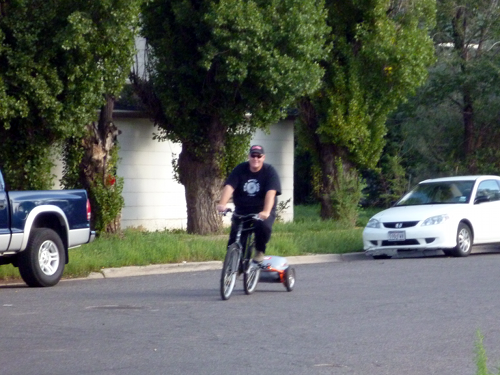At the beginning of this year I went on record with this New Years resolution:
I'm going to eliminate as many of the reasons as I can that require my wife to spend time in a car, beginning with the grocery shopping. I may start with some shopping panniers, but ultimately I may have to go for a long-tail bike, or a bike cargo trailer.

By that I meant, I would do more of the things using a bike that she currently does with the car, so that she doesn’t have to.
I’ve gotten almost nowhere with this resolution. In 2011, just about every grocery run for our household was still done by car — by her.
I suck.
But I think I’ve found a solution to this challenge, as well as my other ambitions to use the car less. The solution is not panniers or a long-tail bike. It’s the Ridekick Electric Trailer.
The Ridekick pushes your bike, and has a little bit of cargo space — enough for two or three grocery bags. At $699, it costs a fraction of the cost of a good electric bike. I don’t need an electric bike anyway. I fall into a gap between people who could really benefit from an electric bike, and people who can get by with pedal power alone.

My city, Flagstaff, Arizona, is relatively small — small enough to bike everywhere. It’s a Silver Level Bike-Friendly Community. But it’s hilly.
I hasten to say, I love the hills. Many marketers of e-bikes incessantly and annoyingly pitch the ability of e-bikes to help you conquer hills — as though the unfulfilled dream of every potential cyclist is to live on a flat earth.
Hills are my friends — but they’re the kind of friends who are never around when you need them to help you move.


What deters me from running errands by bike is the thought of climbing those hills while loaded down with, say, a 35 pound bag of cat food. It’s necessities and times like that when I’m least resistant to the addiction of the car.
Ridekick is a nicotine patch.
(Side note: It occurred to me recently that the Ridekick looks like one of those covered cat litter boxes on wheels. But as a title, “Ridekick: a Litter Box on Wheels” does not really convey my point as well.)
The Ridekick also can easily be shared with any bike that can accommodate the hitch plate — which is most bikes. This would mean that my wife could also have the option of using the Ridekick — allowing me to shirk errands and shopping as much as usual, but with the satisfaction of knowing that the car is being disused.
Even moving the throttle switch and cable from one bike to another only takes a few minutes. I would probably order a separate throttle and cable so even that minor hurdle would be eliminated.
I tested the Ridekick on several bikes, and was able to attach the hitch plate to every one. (The Ridekick Website has a gallery of bikes with dropouts not compatible with the hitch plate.)
I lent the Ridekick to a couple of very different riders for their opinions, and was surprised at their responses.
First was Matt. (Remember him?)
Matt is a triathlete fitness freak who rides a road bike when he’s not on his fixie. I lent the trailer to him in the same spirit that one offers someone a stick of nasty-tasting gum. I expected him to hate it, and it would be hilarious to watch how much he hated it.

In fact, he loved it. We put it on his fixie, and he took it home and said it felt like it made his commute even more fun. He took is feet off the pedals and let them turn. He said he could see himself owning one.
The other guy I lent it to was Steve. (Remember him?)
Much to my surprise, he was singularly unimpressed. We had previously lent him an Ohm XS750 electric bike, which he really liked. But that bike was a little out of his (and my) price range. I thought he would love being able to use his existing bike, but with some electric push.

He said that relative to the Ohm bike, he could hardly feel the power of the Ridekick. That was kind of a head-scratcher. The Ridekick has a more powerful motor than the XS750. The best I can figure is that Steve, who weighs in somewhere above 250 pounds, was just spinning the drive wheel of the Ridekick without enough weight and traction to noticeably accelerate his mass. (I took a physics class once. Can you tell?)

With all the weight-weenie-ism in the cycling world, it’s hard to imagine that a strike against any cycling product would be that it didn’t weigh enough.
The trailer has a 500 watt motor — comparable to high-end electric bikes. It is powered by a sealed lead-acid battery. Battery snobs who are reading this just snorted out loud. But there a couple of reasons for this. First, without your body weight over the drive wheel (as on a bike) the 12-and-a-half-inch drive wheel is likely to spin when you gun it — especially if the trailer is empty. So a little extra weight makes sense. The trailer weighs 40 pounds, including the battery.
The second reason is ecological. Per the Ridekick Website:

Most [sealed lead-acid batteries] are made with 60 "“ 80% recycled lead and plastic, so the recycling processes are well-developed and in place. Consumers can easily find locations to responsibly recycle them (according to federal law, they cannot be deposited in landfills).
There are plans to introduce a lithium-ion battery option sometime in 2012, which will have a better weight-to-power ratio — but not be quite as tree-huggerish.
About one-third of the floor space of the trailer is taken up by the battery, and the cover is probably a little more aerodynamic than it needs to be. These two factors give the Ridekick less cargo capacity than it might otherwise have.
On the other hand, it makes the Ridekick a great canvas for anyone who missed out on having an airbrushed van in the 1970s.

It would be more utilitarian if the trailer had a flatter top with cargo rails. In fact, not far from the Ridekick booth at the Interbike trade show this year was a trailer with this exact feature.

I hope they saw it.
(Ridekick has done some custom cargo racks for their trailers, but these racks are not yet available commercially.)
I beat the hell out of the Ridekick while I was testing it. I tried diligently to flip it — and eventually succeeded when I wasn’t even trying. I scratched up the cover a bit. (Thank goodness I hadn’t invested in a custom paint job.) But my abuse had no effect on the functioning of the trailer.

My commute involves a couple of curb hops, and the trailer is designed to accommodate that. Well, maybe it’s not designed for that, but it does — not always with both wheels on the ground. I was able to skid over the curbs, and use the throttle to help me push the bike up the one particularly rough spot on my commute.
(Point of Machismo: When I’m not pulling a trailer, I can ride up that rough spot without pushing the bike.)

I did manage to break the Velcroâ„¢ strap that holds the battery in place — but it broke while I was over-tightening the strap (an example of how incredibly strong I am), not from any ride conditions to which I subjected it.
I tested the stability of the trailer using a rubber squeak toy. This video shows the highlights of my commute as seen from inside the trailer. My main purpose of the video was to see how well that strap would hold that heavy battery while rattling over a variety of terrain. It’s kind of a boring video, but it’s scenic in a lying-on-your-back-looking-at-clouds kind of way. There’s also a dancing turtle.
(At about 4:10, you’ll see the controversial 50-yard stretch of my commute where I go against traffic on the sidewalk. If you want to harp about that, go to this post to leave your comments.)

The Ridekick doesn’t come with a fancy controller like a BionX kit does, or even with a minimal power meter like a Hebb electric bike. The throttle is just a throttle. You push it with your thumb or finger.
To ascertain any of the vitals on the power use, you need to stop and flip open the lid. (You also need to learn to interpret a language of two-digit codes from the LCD display in the control panel.)
But the Ridekick folks even planned for that. There’s a USB port on the control panel. How cute, right? You can charge your iPhone. Well, as a matter of fact, you can charge your iPhone. But Ridekick is developing a Bluetooth ® dongle that plugs into this USB port that will be able to send wirelessly all of the geeky real-time data you’d ever want to an app on your smart phone.
The Ridekick conforms to the speed restrictions for electric bikes in the US: The top speed is 19 mph. That’s on a flat surface, unassisted by human pedaling. The expected range is 12 to 15 miles, with the usual caveats about the “degree of pedaling combined with Ridekick use, weight of rider, weight of load carried, temperature, terrain, and tire pressure.”
I never ran it until the battery was completely drained — that’s a no-no with lead-acid batteries. But I did run it until it began to lose the some of the pep in its push. This dip in power occurred short of the stated range, but not so much short to give me doubt that the range was accurate. The instructions say to plug in the charger whenever possible, which I did.
I basically used the trailer the way I think I would use it in my real life: as a utilitarian device for occasional cargo hauling and errands; not for a European tour. I guess I didn’t want to find out what it was like to haul a 40-pound trailer plus cargo up those hills on my commute.
I have to think that even the e-bike haters of the world could warm up to this trailer. It’s not a permanent e-bike. It’s there when you want it, and can be left at home when you don’t.
But I’m not looking to persuade the e-bike haters to love this trailer. I’m looking to persuade my wife that I’m not a schmuck — while decreasing our combined car usage.
I think a Ridekick may be the ticket.